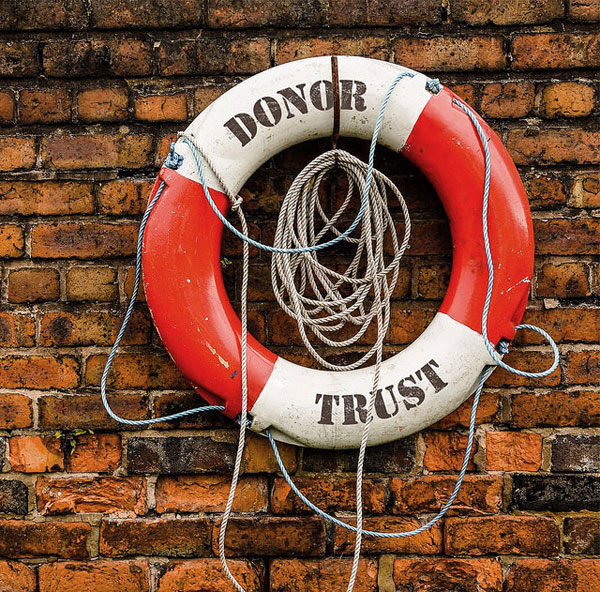
Last week, the New York Times reported on an ongoing pattern of harassment and abuse by Michael Steinhardt, a wealthy and powerful donor to many Jewish organizations. Fundraisers from several nonprofit organizations came forward as a part of the story, sharing their experiences of painfully consistent and inappropriate advances from Steinhardt over a period of many years.
While it’s not often that we see the details of a donor’s harassment of nonprofit employees laid bare in this way, the sad truth is that his is merely one example of many. A study last year by the Association of Fundraising Professionals (AFP) found that nearly one quarter of women in the fundraising profession had experienced harassment, with 65 percent of them reporting that at least one of their harassers was a donor.
While it’s clear that more must be done to combat this significant, sector-wide challenge, the dynamics of donor/nonprofit relationships make that a complicated and challenging issue for boards and senior leadership teams to navigate. Given that reality, AFP and BoardSource offer some tangible advice and guidance.
First and Foremost, Support Your Team
While specific situations of inappropriate behavior may call for differing protocols and responses, there is no question that nonprofit organizations have a responsibility to their staff to support them in any case of inappropriate donor behavior. Never should a fundraiser be asked to tolerate inappropriate behavior “for the good of the cause” (or any other reason). If a fundraiser reports that they are uncomfortable as a result of something that a donor said or did, the organization must take action that prioritizes the fundraiser’s safety and professional workplace standards.
This is especially important because research suggests that fundraisers and other staff who have been harassed are often very disappointed by the response of their organizations. The same AFP study noted above found that the vast majority of fundraising professionals (91 percent) are optimistic that their organization would support them if they personally experienced sexual harassment in the workplace. Yet, of those who have experienced sexual harassment and told their organization, for the most part, generally no action (71 percent) has been taken against the perpetrator. Over half are not satisfied with how their organization responded to their allegation of sexual harassment, and one-third (35 percent) have even felt a negative impact on their career through raising their incidents of harassment.
What sort of action should a nonprofit take? In practice, it will look different depending on the severity of the donor’s behavior and should—when possible—take the fundraiser’s preferences into account. For example, one of the ways that an organization might address inappropriate donor behavior is to “reassign” a donor to another member of the team (often a colleague of the opposite sex of the fundraiser who was harassed). However, for a fundraiser who has invested significant time and energy in cultivating the relationship with the donor or potential donor, this situation might not be their preference. Instead, they may want to have another staff member join them when meeting with the donor, or simply have a record of the harassment so that—if the inappropriate behavior were to become more serious or pervasive—there would be documentation of the issue.
Sign up for our free newsletters
Subscribe to NPQ's newsletters to have our top stories delivered directly to your inbox.
By signing up, you agree to our privacy policy and terms of use, and to receive messages from NPQ and our partners.
Different situations may call for different solutions, but support for the staff member who experienced the harassment must always be the organization’s primary concern. This includes both addressing the immediate issue with the donor and ensuring that the solution doesn’t come at a professional price for the fundraiser.
Set Policies and the Right Tone at the Top
Policies are critical and provide concrete context, boundaries, and expectations for action. However, policies can sometimes be the “floor,” not the “ceiling,” for board or staff behavior, so it’s essential that policies are buttressed by clear and committed tone-setting at the top. This includes the following:
- Communicating the organization’s commitment to addressing issues of harassment in a way that puts employees’ safety first.
- Formalizing a policy that outlines how staff members should report or address issues related to harassment by donors, as well as how to escalate the complaint if it’s not handled appropriately by their supervisor.
- Establishing a written commitment of non-retaliation against fundraisers who report harassment by donors, including mechanisms to ensure that fundraisers will not pay a professional price for reporting bad donor behavior.
- Developing a written code of conduct related to board member behavior that outlines that any board member who has harassed a staff member will be removed from their board position.
- Expanding gift acceptance policies to outline how decisions will be made about whether or not to continue to accept donations from a donor who has had a complaint against them by a staff member (or any other person affiliated with the organization).
- Understanding—and addressing—how the organization’s demographic composition at both the board and staff level could be impacting its leadership. Given the realities of sexual harassment being primarily experienced by female fundraisers and perpetrated by male donors, a board or senior leadership team that is all or primarily male may have real or perceived blind spots that impede its ability to provide the right tone at the top.
Focus on What You Can Control
At the risk of stating the obvious, organizations must acknowledge that—when it comes to preventing sexual harassment of employees—there are many things that are out of the organization’s control. This is not, however, a rationale for an organization to throw its hands up in defeat, as though there was nothing they could do, but instead a case where organizations must be smart and strategic about when, where, and how they do have the ability to exert pressure or control circumstances. So, while an organization cannot control the behaviors of an individual donor, they can control how employees are treated when a situation is reported (supporting your team), as discussed above.
Just as critically, organizations can control how donors or board members are treated after a situation is reported. The organization’s actions should be guided by written policies that have been discussed and approved by the board, as noted above. By following those policies, organizations can be intentional about how a donor’s engagement with the organization—and the individual fundraiser—should be handled. For example:
- Barring the donor from service on the organization’s board. Someone who has behaved inappropriately as a donor should never be considered for a board seat and, if they are on the board already, should be excused from their position. (It’s notable that the AFP study found that 35 percent of fundraisers who experienced sexual harassment said that at least one of their harassers was a board member of their own organization.) Ensuring that the board is not a part of the problem is essential, both in terms of removing problematic behavior as well as ensuring that organizational decision-making is being done by individuals who are committed to a harassment-free workplace.
- Ensuring that the donor is not publicly celebrated or honored by the organization for their leadership or generosity. Nothing says “money reigns supreme” like honoring a donor with a reputation for harassing employees. It’s a terrible message to the staff who experienced the donor’s harassment and will open your organization up to fair and appropriate criticism from your staff and others who are in the know.
- Avoiding inviting the donor to private events. An organization may choose to manage a donor’s participation in organizational events, reducing their opportunities to engage directly with staff. This might be particularly important when a staff member is working an event alone or in a private home, as is often the case with small-group convenings of major donors.
- Sharing with the donor that their behavior was inappropriate. Depending on the situation, it may be appropriate for the organization—from a leadership level—to share with the donor that their behavior made a staff member uncomfortable and to share expectations for engaging with fundraisers in a professional manner. This can be especially effective when donors crossed lines out of a genuine mischaracterization of the relationship with the fundraiser, seeing it as a personal relationship versus a professional one. This is a not uncommon dynamic in the fundraising world, where fundraisers are building relationships with donors and potential donors in the donor’s personal sphere, where behaviors that would be recognized as unprofessional (such as asking someone out on a date) may not seem out of context. In these types of scenarios, a simple reminder that the fundraiser is a doing a job and needs to be treated as a professional can be effective. That said, organizations must consider this approach carefully and in consultation with the fundraiser, as the natural inclination of the donor may be to try to address the issue with the fundraiser who reported the behavior, which may exacerbate the harassment or even create a dangerous confrontation.
- Refraining from soliciting the donor for future support. A stop short of formally cutting ties (but that may have a very similar effect) is for an organization to choose not to resolicit the donor for support. This could apply just to a direct, staff-to-donor solicitation, or could be a complete avoidance of inviting the donor’s support in any form—events, mail, etc.
- Refusing to accept the donor’s support. In accordance with an established gift acceptance policy, there will be situations in which the only appropriate action is to refuse accepting a donor’s gift to the organization.
Sexual harassment by donors is a very real issue in the nonprofit sector; an example of how an imbalance of power can be exploited. The goal within each of our organizations should be to build a culture of respect, equity, and openness so that harassment doesn’t occur—and if it does, employees feel secure and confident that they can approach their supervisor and/or others in the organization and expect an appropriate response.
Reaching that goal won’t happen overnight, but it begins with a series of small steps starting at the top—by organizations taking a look at themselves and developing policies that put their fundraisers and staff first. No donation—and no donor—is worth taking away an individual’s respect and self-worth while turning a blind eye to harassment.













